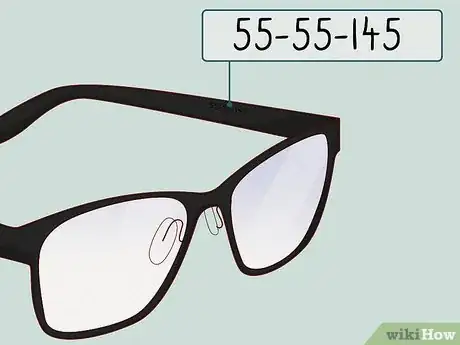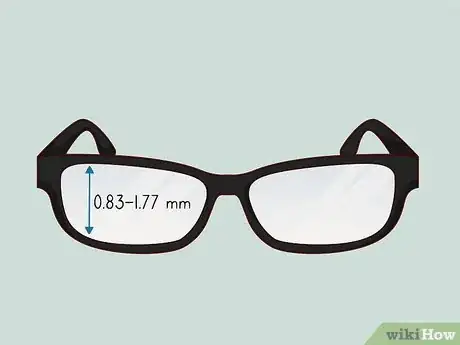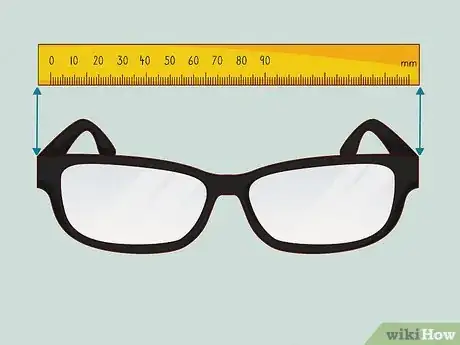This article was co-authored by wikiHow Staff. Our trained team of editors and researchers validate articles for accuracy and comprehensiveness. wikiHow's Content Management Team carefully monitors the work from our editorial staff to ensure that each article is backed by trusted research and meets our high quality standards.
This article has been viewed 23,883 times.
Learn more...
Measuring a pair of glasses frames is relatively simple. If you already have a pair of glasses that fit you well, you may be able to save yourself some work and read the glasses measurements right off of the frame. If not, you can use a ruler to calculate the necessary measurements on a pair of glasses by measuring the dimensions of the frames and of the lenses themselves.
Steps
Measuring the Lenses
-
1Read the 3 numbers on the inside of an arm to find the measurements. There should be 3 numbers printed on the inside of either the left or right temple arm (the long, curved parts that tucks behind your ears). It’ll look something like this: “55-55-145.” These numbers are the glasses’ measurements in millimeters.[1]
- The first number is the glasses’ lens width, the second is the glasses’ bridge width, and the third is the glasses’ temple-arm length.
- If your glasses don’t have this information printed, you’ll need to find those measurements with a ruler.
Tip: In general, all measurements associated with eyeglasses and frames are given in millimeters.
-
2Measure the glasses lenses from side to side to find the lens width. The lenses are the slightly convex pieces of glass, so when you’re measuring lens width, do not measure the metal or plastic surrounding the lens. Simply position your ruler with the “0” resting against 1 edge of the glass and measure horizontally across to the end of the glass lens on the other side.[2]
- In most pairs of glasses, the lens width can vary between 35–60 millimetres (1.4–2.4 in).
- Although the lenses themselves are convex, you do not need to add any extra length to the lens measurements to compensate for the curved lens.
Advertisement -
3Calculate the vertical lens height by measuring from top to bottom. Once you’ve measured the lens width, rotate your ruler 90° to find the lens height. Align 1 end of your ruler with the lowest part of the lens and measure to the highest part. If you’re measuring round lenses, be sure to measure from the very bottom to the very top of the curve.[3]
- Generally speaking, the lens height measurements range from 21–45 millimetres (0.83–1.77 in).
- If you’re hoping to get bifocals or progressive lenses, you’ll need to have a lens height of at least 30 millimetres (1.2 in).
Finding the Frame Dimensions
-
1Measure the width of the frame from top right to top left. Hold your ruler in front of the glasses’ frames and measure the horizontal distance between the farthest-apart points of the glasses. In nearly all cases, this will be the distance between the outside corners of the 2 hinges on the top right and left corners of the frames.
- Measuring the glasses in this way will give you the frame width. Frame width measurements can vary between 110–150 millimetres (4.3–5.9 in).
-
2Take the measurement of the small bar that goes above your nose. This part of the frames is known as the “bridge.” It covers the bridge of your nose and connects the 2 lenses together. Calculate the bridge distance by measuring on top of the bridge of the glasses from where it intersects with the outside edge of 1 of the lens frames to where it intersects with the other lens frame.[4]
- When purchasing new glasses, it’s important that you measure the bridge width as accurately as possible. Try to be accurate to within 2 millimetres (0.079 in). This is important since the glasses won’t fit on your face if the bridge measurement is off.
- Bridge measurements typically only vary between 5–25 millimetres (0.20–0.98 in).
-
3Calculate the length of the temple arms by measuring from end to tip. The arms are a little tricky to measure, since each temple arm bends at about 50° as it curves behind your ear. Place your ruler so the “0” aligns with 1 of the hinges. Measure down the length of the temple arm, and tilt the ruler when you come to the bend in the arm. Continue measuring until you reach the tip of the arm.[5]
- Depending on the size of your glasses, the temple arm measurement can vary from 118–150 millimetres (4.6–5.9 in).
- If you find that it’s too challenging to measure around the bend in the arms, try measuring the arm in 2 different measurements. Measure from the hinge to the center of the bend and then measure from the end of the arm to the center of the bend. Add the 2 numbers together to get the full arm length.
Things You’ll Need
- 1 pair of glasses
- Ruler
References
- ↑ https://www.allaboutvision.com/eyeglasses/faq/eyeglass-frame-size.htm
- ↑ https://www.zennioptical.com/measure-eyeglass-frame-size-how-to
- ↑ https://www.goggles4u.com/eyeglasses_size_guide
- ↑ https://www.zennioptical.com/measure-eyeglass-frame-size-how-to
- ↑ https://www.eyebuydirect.com/guides/frame-measurements
- ↑ https://www.zennioptical.com/measure-eyeglass-frame-size-how-to






























































